We hope more people will know Ri Xing Type Foundry, traditional typecasting technique, and the culture of movable type so that we decided to conduct practical visit, interview and experience in order to dig out unknown and exclusive news that couldn’t be found online.
Grade 6 Class Yi - Chieh-Chang Li
Q: The types are very easy to damage because of collision, but why lead is used as typecasting material instead of other metal?
A:
The lead was used as typecasting material because of low melting point and easy to obtain. As for other metal like tin, copper and wood, they had also been used in the past; however, they were not used anymore because of the expensive costs. In fact, type didn’t use pure lead instead it used alloy that mixed lead with antimony and tin. Antimony was used to advance hardness and fluidity while tin was used to increase fluidity, glossy, and ink-adherence ability. The percentage will be adjusted slightly according to different typecasting machine used.
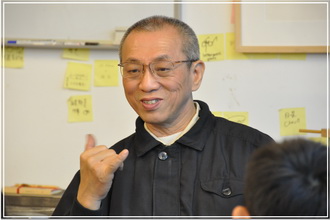 |
 |
Grade 6 Class Ai - Chun-Han Lin
Q: The Lin’s word shelf that Ri Xing Type Foundry used didn’t lose any type because the violent shocking during 921 big earthquake. What is the special feature of Lin’s word shelf? What is the difference from the word shelf that other type foundry used?
A:
The so-called Lin’s word shelf is the name that master Chang given according to the layout of the word shelf. The reason why there was not any word falling down during 921 big earthquake was because the uniqueness of Lin’s word shelf was its presentation of the shape as inverted V and A with the leaning angle of the shelf around 15 degrees. The leaning angle of the shelf at each type foundry is different, but it doesn’t mean the bigger the leaning angle the better because our hands won’t be able to reach the leaning side if the leaning angle is too big. Furthermore, the weight of the type is very heavy; it won’t fall too easily with its weight. However, it won’t be unbearable upon the massive earthquake. Master Chang said humbly that “It was only because the scale of earthquake in Taiwan during 921 big earthquake was only level four. If it were in south part of Taiwan, the type might fall because of the scale of shocking.”
The sequence principle of the word shelf is all the same and the basic pattern of sequence is usually sorting according to the radicals in the dictionary. Some type foundries will sort out the sequence according to common words and seldom used words, but such sequence method doesn’t meet work efficiency; the different sequence means different classification. Most of the word shelves in Taiwan follow the pattern of word shelf from Japanese occupation period, and its pattern follows ergonomics with around 2,000 common words. The range of the work covers the area within the reachable range of a person, and 80 words from the 2,000 common words are put on the so-called cocoon trays exchange. Other type foundry use the sequence method from Japanese ruling period, but it uses the same sequence of Japanese characters. “Lin’s word shelf” that Ri Xing uses is the improvement from master Chang’s uncle, Mr. Lin. Arranging according to the radicals in the dictionary, and there is only one set of regulation needs to be memorized; different from other type foundry that two or three kinds of rules need to be memorized. The work efficiency could be advanced accordingly. Because the uncle is from Taichung, some people don’t call it “Lin’s word shelf” but named it “Taichung word shelf”. Master thought it should be called “Lin’s word shelf because he would like to show his respect to the uncle.
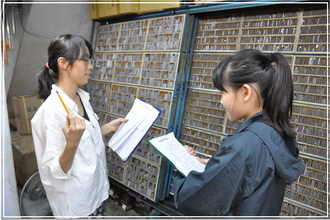 |
 |
Grade 6 Class Yi - Chi-Wei Tsung
Q: All of the movable types we see so far are embossment words; are there any chip carving words? Why does the font only have Song font, Bold font, and Standard Kai font? Has any other font been used?
A:
According to master Chang, there were cut-in words in the beginning but it disappeared gradually because of the convenience and comfort of reading; only embossment printing left now. As for font, there used to have five types including FangSong font, ChangSong font, Song font, Bold font, and Standard Kai font. However, the seldom used two types were rejected because of the decline of typecasting industry between 1981 to 1986; left only the current three types-Song font, Bold font, and Standard Kai font.
Grade 5 Class Yi - Shao-Ting Lin
Q: We know that the decline of movable type was caused by the spread of computer; is there any other huge amount of commission now other than few customers come for type picking-up printing?
A:
According to master Chang, all of the movable type printing plant had lost so-called huge amount of commission 20 or 30 years ago, and it was the reason why the industry declined. If there is still any huge demand of commission, perhaps the industry would not disappear.
Grade 5 Class Yi - Chih-Yu Tsao
Q: Ri Xing Type Foundry is the only remaining traditional character type foundry in the world, and there have been lots of countries who come for an interview because of admiration. Have your visit to Europe this summer brought you any thought or benefit?
A:
I found all of the type foundries in different places were in the critical status when I visited Europe this year. With the loss of the technical talents, a gap appeared; there are very few young people join typecasting industry, and only three young people joined the industry in the recent years.
There are four printing methods in the world:
1. Relief printing: that is movable type.
2. Chip printing: it is used to print paper money.
3. Porous printing: it is used to print the image on clothes or mug.
4. Planographic printing: it was developed from lithography and printed through ink separation.
Most of the people in the world treated movable type as an out-of-date tradition and thought the disappearing of movable type a kind of natural phenomenon; therefore, they were not active in preserving it. In my opinion, each detail of movable type presents the beauty and vitality of the word; an industry might decline and disappear but art will be forever.”
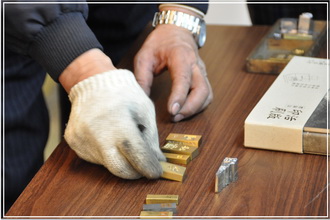 |
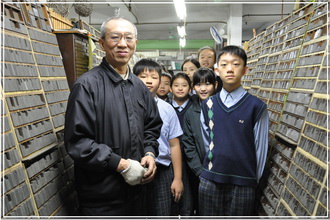 |
Grade 5 Class Jen - Fan-I Li
Q: We found it through collecting the information online that Ri Xing was in fact noticed by general public many years ago, but it seemed that it has not been thought highly by the government. Do you have any new idea in promoting preservation of typecasting culture, master Chang?
A:
Many people usually ask me, “Why has our government never emphasized Ri Xing Type Foundry?” My answer was, “It is because we don’t have government in Taiwan at the moment.” Why? Because our government keeps telling us that we are going to strike back Mainland China to rescue suffering people in China since the age of master Chang’s (year 1951). Therefore, Taiwan is only a revival base and our government doesn’t care about the basic demand that Taiwan needs so far. Strictly speaking, the government in Taiwan has done so-called local construction in the past 60 years and it is a real pity. I believe either the traditional technique of typecasting or the product of the traditional technique is actually carrying a very rich culture. What it left us is the wisdom of human being in the areas of literature, wisdom, and science from the past thousand year that can be understood through words; it will be more difficult to achieve by other kinds of words.
Grade 6 Class Hsin - Pei-Yen An
Q: Currently the retro plan is stopped because of manpower factor. Do you have other proposal, master Chang?
A:
According to master Chang, alternative proposal is using the different approach but with the same target. Just like an old saying goes, “Where there's a will, there's a way.” We can only make a turn and use other approach to solve the problem because our pervious method encountered a wall and hit a snag! In the early days, Ri Xing Type Foundry couldn’t afford the whole retro plan under its economy condition because it needed a quite amazing number, nearly more than one billion dollars, in order to engrave all of the characters in Ri Xing Type Foundry. Therefore, we could only deal with this task with the lowest expense and recruited volunteer so that those who have passion could participate in the work. The problem was that the attitude we held for the problem was too simple and too pure, thinking that if I had the ability to do it, others should be the same; however, it was not like that. Another characteristic of the type is the type is the standard kai font written by calligraphers with a brush, and mold was made according to the handwritings of calligraphers. For engraving these fonts, we need to have a certain level of understanding to calligraphy first and then produce the personality of the master who produced the font through what you know. As the saying goes, “Handwriting shows one's personality” and it means the handwriting of each person could be different according to his personality with some uniqueness inside. After analysis, you must think back to understand the word processing status of the person who writes it; therefore, engraving is in fact even harder than designing a new font style. The fewest numbers in one set of font is our initial font with only just more than 4,000 words while font No.5 and No.6 are both more than 10,000 words. You have to deal with the whole set of words within the huge amounts but have to keep the common feature so that we know whose handwriting it is when we see it. The mistaken we made was not considering whether others had the same judgement and concept but just thought it simply that it would be okay as long as someone was willing to help! The retro plan was stopped because everyone had different concept and processing to the word, and it caused a lot of errors. I am considering recently whether we can repair these words in what we can afford. After the evaluation, the training cost per person is at least five million dollars and it normally needs seven or eight million dollars if I would like to train a group of talents who have the ability to repair the words by myself. It demands at least a group of people because the work load will be too much if only assign one people to do it. By saying a group of people, the minimum should be three to five persons; we will need more than 10 or 20 million dollars if it is only for three people. Currently, it is a very heavy burden for us and Ri Xing is still not able to afford it. We will still think about if there is any other alternative to consider.
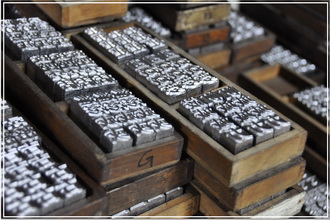 |
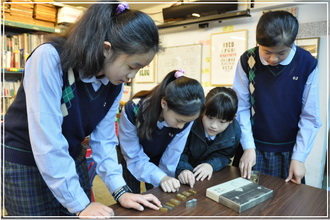 |
Grade 5 Class Jen - Yun-Chen Li
Q: Why do you want to turn “Ri Xing Type Foundry” into interactive museum?
A:
According to master Chang, the biggest difference between interactive museum and museum is that museum tells you the development of the word through presentation. Oracle Bones was followed by Bronze characters which is also inscriptions on ancient bronze objects, then grand sigillary, petit sigillary, official script, regular script, and Chinese characters are developing step by step; then the invention of paper... etc.. The presentation is helping you to understand, but it is always to let you know the knowledge instead of feeling the sense of touch about the technique and knowing the skill beyond the typography. It looks simple but it includes various aspect of knowledge, and the most basic statement is how to produce a printed product on a piece of paper. Only through hand making could we realize the printing process and understand the culture value and contribution of the traditional technique. A good printing product needs delicate printed content, and the understanding towards paper is the understanding of the skills involved in producing paper. What is the feature of the printing ink? There are water-based ink and oil-based ink, and they both have chemical elements; how many elements are able to create delicate printing? It is a real shame that many skills have been gradually lost so master Chang would like to establish a “interactive museum” to pass on the skills in order to provide future generations an opportunity to know these traditional skills.
Grade 6 Class Jen - Yu-Chen Wei
Q: We know these preservation and promotion work won’t be able to be completed in a short time. Will Ri Xing have successors in the future?
A:
I request my children to learn the necessary skills at the moment, and they will need to achieve economic benefits before they can take over the work. Ri Xing Type Foundry has been stayed in the status of debt and loss since 1996, and it must be able to reach an ideal status of the economic benefits before successors are willing to enter the industry. The ideal status mentioned here is not like what Tai-Ming Kuo has because it is definitely impossible, but just need to cover the general daily expense. More and more people start to know “Ri Xing Type Foundry” slowly because of the media report recently; with people come to visit Ri Xing and spend money out of admiration, the economic situation starts getting better. Will this be able to support a type foundry? Frankly speaking, the gap is still very big! With the facility and equipment that Ri Xing Type Foundry has without mentioning update the equipment inside, it needs more than one billion dollars. It is very difficult to fully use it and keep the business under the status of balance between benefit and cost without business turnover of more than one million dollars a month; Ri Xing still has a long way to go! We could not give up the ideal because of the difficult situation, and there is a popular saying: “Having a dream is the most beautiful thing.” This is a goal that I can pursuing and I hope to complete our dream as possible as it can, but it needs lots of effort as well as a lot of various resources because it is a dying traditional industry. In Taiwan, we only have one remaining typecasting foundry and less than 30 printing plants. In order to support a type foundry in the scale as Ri Xing, it requires at least more than 300 printing plants operating properly but not like less than three days of work each month at the moment.
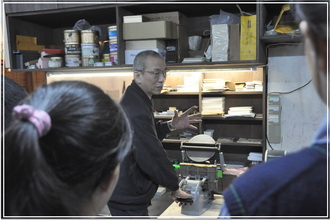 |
 |
Future expectation
Master Chang said, “My biggest wish is to establish a movable type interactive museum for Taiwan because of my love to the land of Taiwan. I happen to work in this industry and it has its uniqueness towards the human cultural heritage, and I happen to be the leader of the industrial system. There won’t be some of the movable type technique without it, and I hope to save the forgotten traditional technique as possible as I can through what I can do based on the current situation. Besides, Ri Xing Type Foundry is the most painstaking care of my father’s whole life. I would like to use it as the memorization to my father through the preservation of Ri Xing because it is very important for me to pass on my father’s technique.”
Data compilation: Chun-Han, Fan-Yi
Photo taken by the camera team of CRS

|

